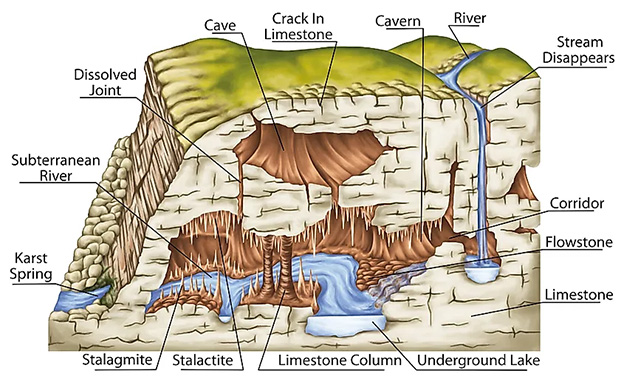Q. What is karst topography? Describe its characteristics and significance. (250 words)
24 Apr, 2023 GS Paper 1 GeographyApproach
- Start your answer with a brief introduction about the karst topography.
- Discuss the characteristics and significance separately.
- Conclude accordingly.
Introduction
- Karst topography is a type of landscape that is formed by the dissolution of soluble rocks such as limestone, dolomite, and gypsum. Conditions that promote karst development are well-jointed, dense limestone near the surface; moderate to heavy rainfall; and good groundwater circulation.
- This unique topography is characterized by sinkholes, disappearing streams, caves, and underground drainage systems.
- Karst topography is found in many regions around the world and has significant ecological, geological, and human importance.
Body
Characteristics of Karst topography
Erosional landforms that characterize karst topography:
- Sinkholes:
- Sinkholes are circular depressions in the ground that are formed when the overlying soil and rock collapse into underground cavities.
- Caves:
- Caves are underground chambers and passages that are formed by the dissolution of rock. These can range from small cavities to large, complex systems that span many miles.
- Mammoth Cave National Park, Kentucky, USA:
- This park is home to the world's longest known cave system, with over 650 km of explored passageways.
- Lapies:
- It is formed due to differential solution activity along parallel to sub-parallel joints.
- They are also called grooved, fluted and ridge-like features in an open limestone field.
Depositional landforms that characterize karst topography:
- Stalactite:
- A portion of the roof hangs on the roof and on evaporation of water, a small deposit of limestone is left behind contributing to the formation of a stalactite, growing downwards from the roof.
- Stalagmite:
- The remaining portion of the drop falls to the floor. This also evaporates, leaving behind a small deposit of limestone aiding the formation of a stalagmite, thicker and flatter, rising upwards from the floor.
- Column:
- Sometimes, stalactite and stalagmite join together to form a complete pillar known as the column.
- Ha Long Bay, Vietnam:
- This UNESCO World Heritage Site is known for its tower-like limestone formations, which are formed by Karst Topography.
Other Characteristics:
- Disappearing Streams:
- Disappearing streams are streams that flow into the ground and disappear into underground drainage systems.
- Underground Lake:
- Most naturally occurring underground lakes are found in areas of Karst topography, where limestone or other soluble rock has been weathered away, leaving a cave where water can flow and accumulate.
Significance of Karst Topography:
- Geological Significance:
- The dissolution of soluble rocks results in the formation of complex underground drainage systems, which can lead to the creation of vast cave systems.
- These caves can contain important geological formations, such as stalactites, stalagmites, and flowstones, which provide insights into the Earth's geological history.
- Human Significance:
- Many karst regions around the world are used for agriculture and forestry, and they provide important sources of raw materials, such as limestone for construction.
- However, human activities can also have negative impacts on karst ecosystems, such as groundwater contamination and soil erosion.
- Ecological Significance:
- It provides habitats for a diverse range of plant and animal species, many of which are unique to karst environments.
- The porous nature of the rock formations allows water to seep through and form underground aquifers, which provide important sources of freshwater for drinking, irrigation, and industry.
Conclusion
- Karsts are found in widely scattered sections of the world, including the caucus of France; the Kwangsi area of China; the Yucatan Peninsula in the United States. Human activities have negative impacts on karst ecosystems, and it is important to protect and preserve these fragile landscapes.
